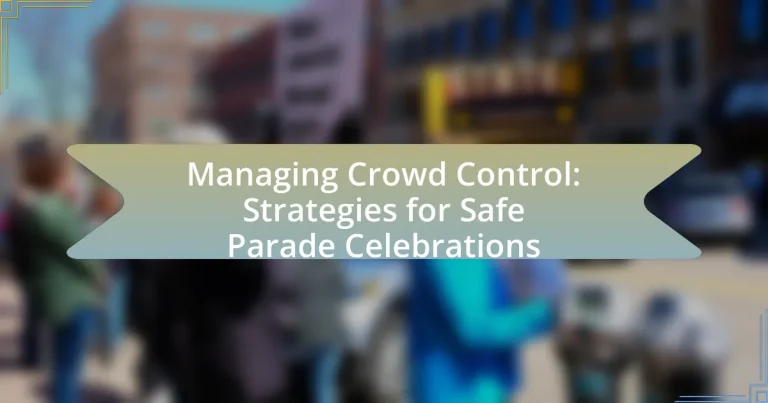The article focuses on managing crowd control during parade celebrations, emphasizing the importance of effective planning, clear communication, and strategic personnel deployment. Key elements discussed include the enhancement of safety through organized movement, the identification of potential risks associated with large crowds, and the implementation of crowd management strategies such as barriers and designated viewing areas. Additionally, the article highlights the role of technology in crowd monitoring, legal considerations for event organizers, and best practices for training staff to ensure a safe and enjoyable experience for all attendees.

What are the key elements of managing crowd control during parade celebrations?
The key elements of managing crowd control during parade celebrations include effective planning, clear communication, and strategic deployment of personnel. Effective planning involves assessing the expected crowd size, identifying potential hazards, and establishing designated areas for spectators and participants. Clear communication ensures that all stakeholders, including law enforcement, event staff, and attendees, understand the rules and procedures, which can be facilitated through signage and announcements. Strategic deployment of personnel, such as security and volunteers, is crucial for monitoring crowd behavior and responding to emergencies. These elements are supported by historical data indicating that well-organized crowd control measures significantly reduce incidents of injury and disorder during large public events.
How does effective crowd control enhance safety during parades?
Effective crowd control enhances safety during parades by ensuring organized movement and preventing overcrowding. This structured management reduces the risk of accidents, such as trampling or injuries, by maintaining clear pathways and designated areas for spectators and participants. Historical data from events like the 2017 New Year’s Eve celebration in New York City, where extensive crowd control measures were implemented, demonstrated a significant decrease in incidents, showcasing that proactive management can lead to safer environments during large gatherings.
What are the potential risks associated with large crowds at parades?
Large crowds at parades pose several potential risks, including crowd crushes, injuries, and difficulties in emergency response. Crowd crushes can occur when individuals are pushed together tightly, leading to suffocation or trampling, as evidenced by incidents like the 1989 Hillsborough disaster, where 96 people died due to overcrowding. Injuries can arise from falls, collisions, or other accidents, particularly in chaotic environments where people are jostling for space. Additionally, large crowds complicate emergency response efforts, as first responders may struggle to navigate through dense populations, delaying critical assistance during medical emergencies or security threats. These risks highlight the importance of effective crowd management strategies to ensure safety during parade celebrations.
How can crowd control measures mitigate these risks?
Crowd control measures can mitigate risks by establishing clear pathways and designated areas for attendees, which reduces congestion and potential hazards. Effective crowd management strategies, such as the use of barriers, signage, and trained personnel, help direct the flow of people, minimizing the likelihood of stampedes or injuries. Historical data from events like the 2017 Manchester Arena attack highlights that proper crowd control can prevent panic and chaos, thereby enhancing safety. Additionally, implementing real-time monitoring systems allows for quick responses to emerging issues, further decreasing risks associated with large gatherings.
What strategies are commonly used for crowd management at parades?
Common strategies for crowd management at parades include the use of barriers, designated viewing areas, crowd control personnel, and communication systems. Barriers, such as fences or cones, help to direct the flow of pedestrian traffic and prevent overcrowding in specific areas. Designated viewing areas allow for organized seating and standing spaces, ensuring that spectators have a clear line of sight while maintaining safety. Crowd control personnel, including police and event staff, monitor the crowd and enforce safety protocols, which is crucial for managing large groups effectively. Communication systems, such as public address announcements and digital signage, provide real-time information to attendees, helping to guide them and reduce confusion. These strategies are supported by historical data indicating that organized crowd management significantly decreases the likelihood of accidents and enhances the overall experience for participants and spectators alike.
What role does planning play in successful crowd control?
Planning is essential for successful crowd control as it establishes clear protocols and strategies to manage large groups effectively. Effective planning involves assessing potential risks, determining crowd flow, and allocating resources such as personnel and equipment. For instance, events like the 2012 London Olympics demonstrated that thorough planning, including crowd management simulations and real-time monitoring, significantly reduced incidents and ensured safety. By anticipating challenges and preparing responses, planning enhances the ability to maintain order and respond to emergencies, ultimately leading to a safer environment for participants and spectators.
How can technology assist in managing crowds effectively?
Technology can assist in managing crowds effectively through the use of real-time data analytics, crowd monitoring systems, and communication tools. Real-time data analytics allows event organizers to track crowd density and movement patterns, enabling them to make informed decisions to redirect or disperse crowds as needed. Crowd monitoring systems, such as surveillance cameras and drones, provide visual insights into crowd behavior, helping to identify potential issues before they escalate. Additionally, communication tools, including mobile apps and social media platforms, facilitate timely updates and alerts to attendees, enhancing safety and coordination during events. For instance, studies have shown that cities employing smart technology for crowd management have reported a significant reduction in incidents during large gatherings, demonstrating the effectiveness of these technological solutions.
What are the legal considerations in crowd control for public events?
Legal considerations in crowd control for public events include compliance with local laws, liability issues, and the protection of attendees’ rights. Event organizers must obtain necessary permits and adhere to regulations regarding crowd size, safety measures, and emergency protocols. Liability concerns arise from potential injuries or damages, necessitating adequate insurance coverage. Additionally, organizers must respect individuals’ rights to free speech and assembly, ensuring that crowd control measures do not infringe upon these rights. Failure to address these legal aspects can result in fines, lawsuits, or event cancellations.
What regulations must organizers comply with for crowd safety?
Organizers must comply with local, state, and federal regulations regarding crowd safety, including fire codes, occupancy limits, and emergency response protocols. These regulations are designed to ensure the safety of attendees by establishing guidelines for crowd management, such as maintaining clear exit routes, providing adequate medical services, and implementing crowd control measures. For instance, the National Fire Protection Association (NFPA) outlines specific occupancy limits based on venue size and layout, which helps prevent overcrowding and potential hazards. Additionally, the Americans with Disabilities Act (ADA) mandates accessibility standards that organizers must follow to ensure all attendees can safely participate in events.
How can liability issues be addressed in crowd management plans?
Liability issues in crowd management plans can be addressed by implementing comprehensive risk assessments and establishing clear protocols for emergency situations. Conducting thorough risk assessments allows event organizers to identify potential hazards and vulnerabilities, which can then be mitigated through strategic planning. For instance, the National Fire Protection Association emphasizes the importance of crowd control measures to prevent overcrowding and ensure safe egress, thereby reducing liability risks. Additionally, training staff in emergency response and crowd management techniques ensures that they are prepared to handle incidents effectively, further minimizing the likelihood of liability claims.
How can communication improve crowd control during parades?
Effective communication enhances crowd control during parades by ensuring timely information dissemination among organizers, security personnel, and attendees. Clear communication channels allow for real-time updates on crowd density, emergency situations, and changes in the parade schedule, which can significantly reduce confusion and panic. For instance, studies have shown that events with established communication protocols, such as the use of two-way radios among staff and social media updates for the public, experience fewer incidents of overcrowding and safety breaches. This proactive approach to communication not only facilitates better coordination among teams but also empowers attendees to make informed decisions, ultimately leading to a safer and more enjoyable parade experience.
What methods are effective for communicating with attendees?
Effective methods for communicating with attendees include using clear signage, mobile apps, and public address systems. Clear signage provides essential information about event schedules, safety protocols, and directions, ensuring attendees can navigate the event easily. Mobile apps facilitate real-time updates and notifications, allowing organizers to communicate changes or important announcements directly to attendees’ devices. Public address systems enable organizers to reach large crowds quickly, delivering important messages or instructions effectively. These methods enhance attendee awareness and safety during events, as evidenced by studies showing that clear communication reduces confusion and improves overall event satisfaction.
How can real-time updates enhance crowd safety?
Real-time updates enhance crowd safety by providing immediate information about potential hazards or emergencies, allowing individuals and authorities to respond swiftly. For instance, during large events, real-time alerts can inform attendees about changes in crowd flow, weather conditions, or security threats, enabling them to make informed decisions. Studies have shown that timely communication can reduce panic and improve evacuation efficiency; for example, the 2017 Manchester Arena bombing highlighted the importance of real-time updates in guiding crowd movement and ensuring safety.
What are the best practices for training staff in crowd control techniques?
The best practices for training staff in crowd control techniques include comprehensive training programs that emphasize communication, situational awareness, and de-escalation strategies. Effective training should incorporate realistic simulations and role-playing scenarios to prepare staff for various crowd dynamics. Research indicates that training programs that include hands-on exercises and feedback improve staff confidence and effectiveness in real situations. For instance, a study by the International Association of Chiefs of Police found that agencies employing scenario-based training reported a 30% increase in successful crowd management outcomes. Additionally, ongoing training and refresher courses are essential to keep staff updated on best practices and emerging challenges in crowd control.
What skills should staff members possess for effective crowd management?
Staff members should possess strong communication, situational awareness, conflict resolution, and leadership skills for effective crowd management. Effective communication enables staff to convey important information clearly to the crowd, reducing confusion and enhancing safety. Situational awareness allows staff to assess the environment and identify potential risks or issues before they escalate. Conflict resolution skills are essential for addressing disputes or disturbances calmly and efficiently, minimizing disruption. Leadership skills empower staff to guide and direct crowds effectively, ensuring orderly movement and compliance with safety protocols. These skills collectively contribute to a safer and more organized crowd management process during events like parade celebrations.
How can simulations and drills prepare staff for real scenarios?
Simulations and drills prepare staff for real scenarios by providing hands-on experience in a controlled environment, allowing them to practice responses to various situations. This practical training enhances decision-making skills, improves teamwork, and builds confidence under pressure. Research indicates that organizations employing regular simulations report a 30% increase in staff readiness for emergency situations, demonstrating the effectiveness of such training in real-world applications.
What are the common challenges faced in crowd control at parades?
Common challenges faced in crowd control at parades include managing large crowds, ensuring public safety, and coordinating emergency responses. Large crowds can lead to congestion and potential hazards, making it difficult for law enforcement and event organizers to maintain order. Public safety is compromised when individuals engage in risky behaviors, such as excessive alcohol consumption or unauthorized access to restricted areas. Additionally, the need for effective communication among various agencies, including police, medical services, and event staff, is crucial for a coordinated emergency response, as evidenced by incidents where lack of communication has exacerbated dangerous situations.
How can unexpected situations be handled during a parade?
Unexpected situations during a parade can be handled by implementing a well-defined emergency response plan. This plan should include clear communication protocols among staff, volunteers, and emergency services to ensure rapid response to incidents such as medical emergencies, crowd surges, or severe weather. For instance, the National Safety Council emphasizes the importance of having trained personnel on-site who can quickly assess situations and coordinate with local authorities, which enhances safety and minimizes chaos. Additionally, utilizing crowd management techniques, such as designated evacuation routes and barriers, can help maintain order and facilitate a swift response to unexpected events.
What strategies can be implemented to adapt to crowd behavior?
To adapt to crowd behavior, implementing real-time monitoring and crowd management technologies is essential. These strategies include utilizing surveillance systems, crowd analytics software, and social media monitoring to assess crowd dynamics and predict potential issues. For instance, studies have shown that real-time data collection can reduce incidents by up to 30% during large events by allowing organizers to make informed decisions quickly. Additionally, establishing clear communication channels with attendees through apps or public announcements can help guide crowd movement and ensure safety.
What practical tips can enhance crowd control at parade celebrations?
Implementing clear communication strategies enhances crowd control at parade celebrations. Establishing designated communication channels, such as loudspeakers or digital signage, ensures that attendees receive timely information about safety protocols and event updates. Additionally, deploying trained personnel to guide and manage crowds can significantly reduce congestion and improve safety. Historical data from events like the 2017 New Year’s Eve celebration in New York City, which utilized extensive crowd management techniques, demonstrated a decrease in incidents and improved attendee experience.





